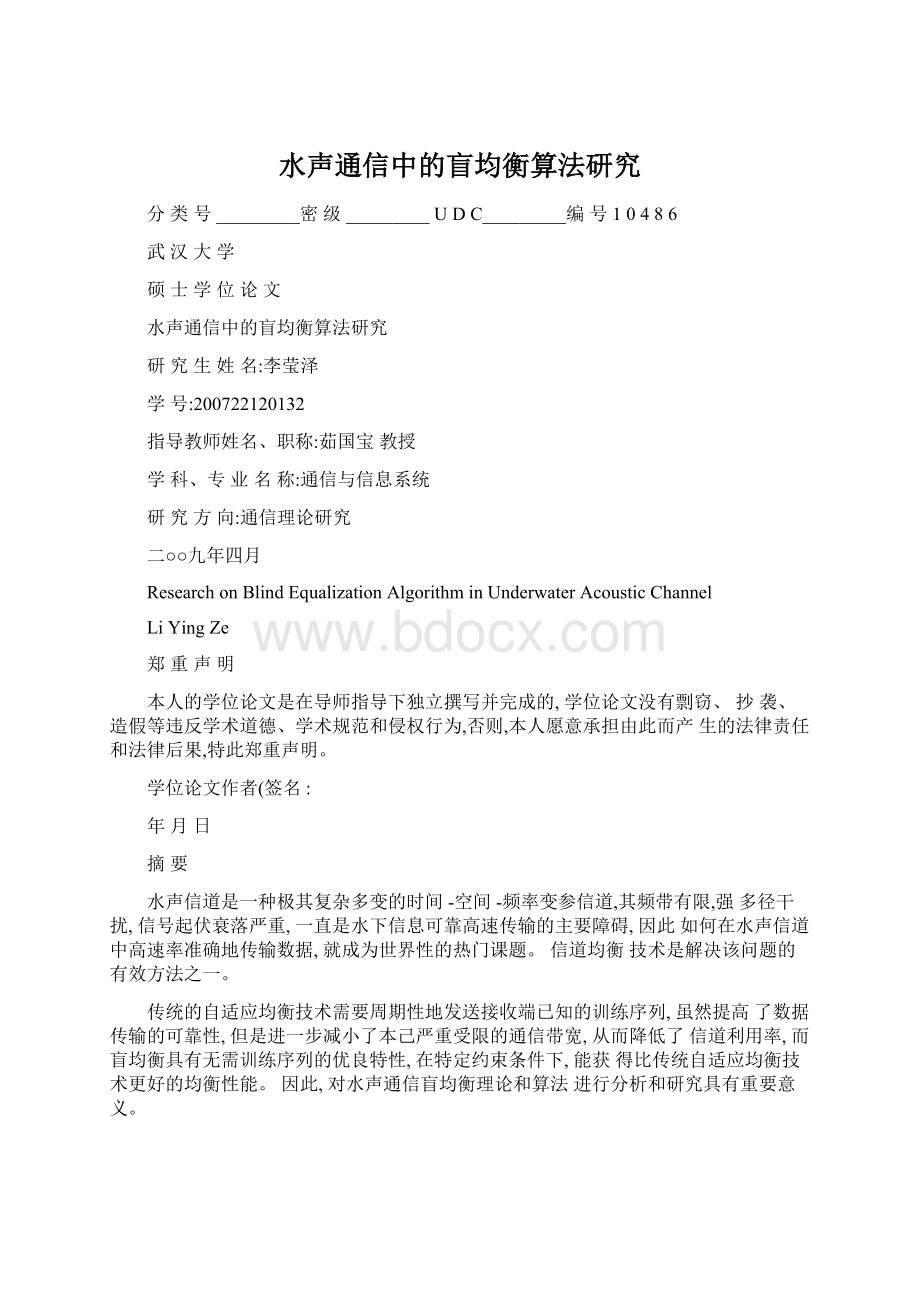 水声通信中的盲均衡算法研究.docx
水声通信中的盲均衡算法研究.docx
- 文档编号:1823878
- 上传时间:2022-10-24
- 格式:DOCX
- 页数:44
- 大小:311.68KB
水声通信中的盲均衡算法研究.docx
《水声通信中的盲均衡算法研究.docx》由会员分享,可在线阅读,更多相关《水声通信中的盲均衡算法研究.docx(44页珍藏版)》请在冰豆网上搜索。

水声通信中的盲均衡算法研究
分类号_________密级_________UDC_________编号10486
武汉大学
硕士学位论文
水声通信中的盲均衡算法研究
研究生姓名:
李莹泽
学号:
200722120132
指导教师姓名、职称:
茹国宝教授
学科、专业名称:
通信与信息系统
研究方向:
通信理论研究
二○○九年四月
ResearchonBlindEqualizationAlgorithminUnderwaterAcousticChannel
LiYingZe
郑重声明
本人的学位论文是在导师指导下独立撰写并完成的,学位论文没有剽窃、抄袭、造假等违反学术道德、学术规范和侵权行为,否则,本人愿意承担由此而产生的法律责任和法律后果,特此郑重声明。
学位论文作者(签名:
年月日
摘要
水声信道是一种极其复杂多变的时间-空间-频率变参信道,其频带有限,强多径干扰,信号起伏衰落严重,一直是水下信息可靠高速传输的主要障碍,因此如何在水声信道中高速率准确地传输数据,就成为世界性的热门课题。
信道均衡技术是解决该问题的有效方法之一。
传统的自适应均衡技术需要周期性地发送接收端已知的训练序列,虽然提高了数据传输的可靠性,但是进一步减小了本己严重受限的通信带宽,从而降低了信道利用率,而盲均衡具有无需训练序列的优良特性,在特定约束条件下,能获得比传统自适应均衡技术更好的均衡性能。
因此,对水声通信盲均衡理论和算法进行分析和研究具有重要意义。
论文首先概述了水声通信和盲均衡技术的背景和水声信道的信道特性,系统地分析了盲均衡的基本理论、算法形式以及盲均衡采用的决策指向(DD、Sato、Godard三种常用的Bussgang类盲均衡算法,强调了均衡算法的收敛性能对整体系统的影响。
然后,在重点分析、理论推导恒模盲均衡算法的基础上,对传统恒模盲均衡算法的收敛性能进行了仿真。
仿真结果表明,采用大步长,能够加快收敛速度,但同时会带来较大的稳态剩余误差;采用小步长,虽然减小了算法收敛后的稳态剩余误差,但算法收敛速度过慢。
最后,为了解决收敛速度和收敛精度之间存在的矛盾,论文将剩余误差的非线性变换作为步长的控制因子,建立了一种新的变步长恒模盲均衡算法。
理论分析和计算机仿真实验表明:
改进算法与传统恒模盲均衡算法相比,能够有效地加快收敛速度,并能收敛到更小且稳定的剩余误差,从而降低了传输误码率,极大地改善了水声通信的质量。
关键词:
盲均衡算法,恒模算法,剩余误差的非线性变换,变步长
Abstract
OneofthemainobstaclestoreliableunderwateracousticdigitalcommunicationsisconsideredtobeInter-SymbolInterference(ISI,whichismainlycausedbymultipathpropagation.EqualizationtechniqueisaneffectiveapproachtosuppressISI.
Underwateracousticchannelisseverelyband-limitedduetohighabsorption,andconventionaladaptiveequalizations,whichrequiretrainingsequencestransmittedperiodically,willreducetheusablebandwidthfurther.Howeverblindequalizationdoesnotneedthetrainingsequence,thetheoryandthepracticeproved,blindequalizationmayundercertaintraditional,adaptiveequalizationtechnologyinvalidconditions,stillhasgoodperformance,underspecificconstraintcondition,itcanobtainbetterequalizationperformancethantraditionaladaptiveequalizationtechnology.Withthedevelopmentofmodernizedunderwateracousticcommunicationtothehighspeedinformationtransmissiondemand,ithasthevitalsignificancethatanalysisandtheresearchofblindequlizationthroryalgorithm.Themainjobsofthisthesisareasfollows:
First,thebackgroundandthedevelopmentoftheunderwateracousticcommunicationandtheblindequalizationareresumptivelyintroduced,thecharacteristicoftheunderwateracousticchannelissummarized.
Second,thebasictheory,algorithmformofblindequalization,thebasicalgorithmandconvergencecriterionofitaresystematicallyanalyzed.ThebasictheoryandpropertyofBussgangblindequalizationalgorithmaredescribedandthreealgorithmsincludingDecision-Directedalgorithm、Satoalgorithm、GodardalgorithmincommonusedofBussgangareintroduced.
Finally,CMAblindequalizationalgorithmofBussgangalgorithmsistheemphasis.TheCMAalgorithmisderivedandtheconvergenceperformanceoftraditionalCMAalgorithmisanalyzed.Simulationresultsprovedtoshowthattheconvergencespeedisquicker,butwithalargerresidualerrorifbiggerstepisadopted.Inordertominimizetheresidualerrorafterconvergence,thesmallerstepshouldbeadopted,butatthesametime,theconvergencespeedisslow.Andthen,anewvariablestep-sizeCMAblindequalizationalgorithmisproposedinordertosolvetheantinomybetweentheconvergencerateandaccuracybecauseofusingthefixedstep.
Thenewalgorithmmakesuseofthenon-linearfunctionoferrorsignalastheparametertoproducethenewvariablestepsize.ThetheoreticalanalysisandthesimulationresultsprovedtoshowthatthenewalgorithmhasimprovedperformanceoftheconvergencespeedandresidualerrorthantraditionalCMAalgorithmandcanbeappliedintheself-adaptiveblindequalizationsystemavailably.
KEYWORDS:
blindequalization,constantmodulusalgorithm,bussgangproperty,thenon-linearfunctionoferrorsignal,variablestep-size
摘要.............................................................................................................................................IAbstract..........................................................................................................................................II目录.............................................................................................................................................11.绪论.......................................................................................................................................11.1.引言...............................................................................................................................11.2.水声通信的发展与现状...............................................................................................21.3.盲均衡技术的发展与现状...........................................................................................3
- 配套讲稿:
如PPT文件的首页显示word图标,表示该PPT已包含配套word讲稿。双击word图标可打开word文档。
- 特殊限制:
部分文档作品中含有的国旗、国徽等图片,仅作为作品整体效果示例展示,禁止商用。设计者仅对作品中独创性部分享有著作权。
- 关 键 词:
- 通信 中的 均衡 算法 研究
 冰豆网所有资源均是用户自行上传分享,仅供网友学习交流,未经上传用户书面授权,请勿作他用。
冰豆网所有资源均是用户自行上传分享,仅供网友学习交流,未经上传用户书面授权,请勿作他用。


 《巴黎圣母院》3000字读书心得范文.docx
《巴黎圣母院》3000字读书心得范文.docx
